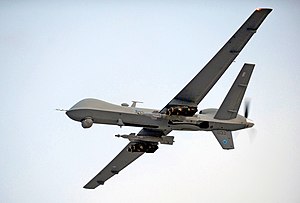
Targeted killing is a form of assassination carried out by governments outside a judicial procedure or a battlefield.[1][2][3][4]
Since the late 20th century, the legal status of targeted killing has become a subject of contention within and between various nations. Historically, at least since the mid-eighteenth century, Western thinking has generally considered the use of assassination as a tool of statecraft to be illegal.[5] Some academics, military personnel and officials[6] describe targeted killing as legitimate within the context of self-defense, when employed against terrorists or combatants engaged in asymmetrical warfare. They argue that unmanned combat aerial vehicles (drones) are more humane and more accurate than manned vehicles.[7][8]
Scholars are also divided as to whether targeted killings are an effective counterterrorism strategy.[9][10][11][12][13][14]
- ^ Greenwald, Glenn (24 October 2012). "Obama moves to make the War on Terror permanent | Glenn Greenwald". The Guardian. ISSN 0261-3077. Retrieved 22 July 2019.
- ^ Pollack, Kenneth M. (7 March 2018). "Learning From Israel's Political Assassination Program". The New York Times. ISSN 0362-4331. Retrieved 22 July 2019.
- ^ Mann, James (14 June 2012). The Obamians: The Struggle Inside the White House to Redefine American Power. Penguin. p. 410. ISBN 9781101583616.
- ^ Lynn, John A. (23 July 2019). Another Kind of War: The Nature and History of Terrorism. Yale University Press. p. 410. ISBN 9780300188813.
- ^ Cite error: The named reference
CSSwas invoked but never defined (see the help page). - ^ "Targeted Killings". Council on Foreign Relations. Archived from the original on 10 February 2015. Retrieved 15 February 2015.
- ^ Carroll, Rory (2 August 2012). "The philosopher making the moral case for US drones". The Guardian. London. Archived from the original on 18 February 2017. Retrieved 16 December 2016.
- ^ Shane, Scott (14 July 2012). "The Moral Case for Drones". The New York Times. Archived from the original on 18 February 2017. Retrieved 13 February 2017.
- ^ Press, Stanford University (2019). Leadership Decapitation: Strategic Targeting of Terrorist Organizations | Jenna Jordan. Stanford University Press. ISBN 9781503608245. Retrieved 3 January 2020 – via www.sup.org.
- ^ Jordan, Jenna (April 2014). "Attacking the Leader, Missing the Mark: Why Terrorist Groups Survive Decapitation Strikes". International Security. 38 (4): 7–38. doi:10.1162/ISEC_a_00157. ISSN 0162-2889. S2CID 57569755.
- ^ Frankel, M. (2010). "The ABCs of HVT: Key Lessons from High Value Targeting Campaigns Against Insurgents and Terrorists". Studies in Conflict and Terrorism. 34: 17–30. doi:10.1080/1057610x.2011.531456. S2CID 110265235.
- ^ Jordan, Jenna (2 December 2009). "When Heads Roll: Assessing the Effectiveness of Leadership Decapitation". Security Studies. 18 (4): 719–755. doi:10.1080/09636410903369068. ISSN 0963-6412. S2CID 59496454.
- ^ Johnston, Patrick B. (1 April 2012). "Does Decapitation Work? Assessing the Effectiveness of Leadership Targeting in Counterinsurgency Campaigns". International Security. 36 (4): 47–79. doi:10.1162/ISEC_a_00076. ISSN 0162-2889. S2CID 53519659.
- ^ Price, Bryan C. (1 April 2012). "Targeting Top Terrorists: How Leadership Decapitation Contributes to Counterterrorism". International Security. 36 (4): 9–46. doi:10.1162/ISEC_a_00075. ISSN 0162-2889. S2CID 15188795.